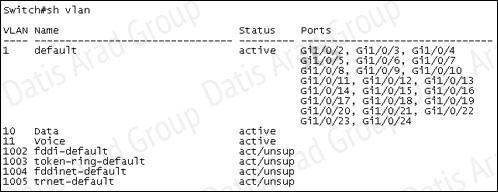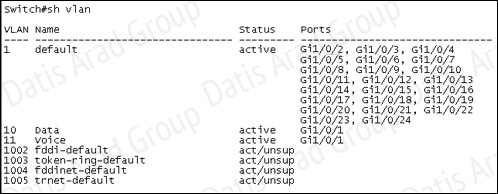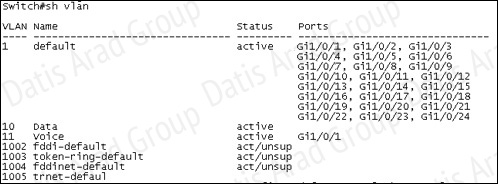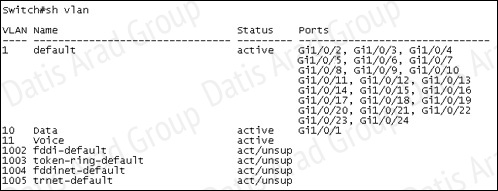
نمونه سوالات آزمون
Implementing Cisco IP Switched Networks - exam 300-115
Topic 1, Layer 2 Technologies
QUESTION NO: 61
What is the default interval at which Cisco devices send Cisco Discovery Protocol advertisements?
A. 30 seconds
B. 60 seconds
C. 120 seconds
D. 300 seconds
Answer: B
Explanation:
Cisco Discovery Protocol is a Layer 2, media-independent, and network-independent protocol that networking applications use to learn about nearby, directly connected devices. Cisco Discovery Protocol is enabled by default. Each device configured for Cisco Discovery Protocol advertises at least one address at which the device can receive messages and sends periodic advertisements (messages) to the well-known multicast address 01:00:0C:CC:CC:CC. Devices discover each other by listening at that address. They also listen to messages to learn when interfaces on other devices are up or go down.
Advertisements contain time-to-live information, which indicates the length of time a receiving device should hold Cisco Discovery Protocol information before discarding it.Advertisements supported and configured in Cisco software are sent, by default, every 60 seconds.
QUESTION NO: 62
Which statement about Cisco Discovery Protocol configuration on a Cisco switch is true?
A. CDP is enabled by default and can be disabled globally with the command no cdp run.
B. CDP is disabled by default and can be enabled globally with the command cdp enable.
C. CDP is enabled by default and can be disabled globally with the command no cdp enable.
D. CDP is disabled by default and can be enabled globally with the command cdp run.
Answer: A
Explanation:
CDP is enabled on your router by default, which means the Cisco IOS software will receive CDP information. CDP also is enabled on supported interfaces by default. To disable CDP on an interface, use the “no cdp enable interface” configuration command. To disable it globally, use the “no cdp run” command.
QUESTION NO: 63
Which VTP mode is needed to configure an extended VLAN, when a switch is configured to use VTP versions 1 or 2?
A. transparent
B. client
C. server
D. Extended VLANs are only supported in version 3 and not in versions 1 or 2.
Answer: D
Explanation:
VTP version 1 and version 2 support VLANs 1 to 1000 only. Extended-range VLANs are supported only in VTP version 3. If converting from VTP version 3 to VTP version 2, VLANs in the range 1006 to 4094 are removed from VTP control.
QUESTION NO: 64
What is the size of the VLAN field inside an 802.1q frame?
A. 8-bit
B. 12-bit
C. 16-bit
D. 32-bit
Answer: B
Explanation:
The VLAN field is a 12-bit field specifying the VLAN to which the frame belongs. The hexadecimal values of 0x000 and 0xFFF are reserved. All other values may be used as VLAN identifiers, allowing up to 4,094 VLANs.
QUESTION NO: 65
What is the maximum number of VLANs that can be assigned to an access switchport without a voice VLAN?
A. 0
B. 1
C. 2
D. 1024
Answer: B
Explanation:
A standard (non-voice VLAN port) access switch port can belong to only a single VLAN. If more than one VLAN is needed, the port should be configured as a trunk port.
QUESTION NO: 66
Refer to the exhibit.

Which option shows the expected result if a show vlan command is issued?
A.
B. 
C.
D.
Answer: A
Explanation:
In this case, the port has been configured both as a trunk and as a switchport in data vlan 10. Obviously, a port can not be both, soeven thoughCisco IOSwill accept both, the port will actually be used as a trunk, ignoring the switchport access VLAN 10 command.
QUESTION NO: 67
Which feature is automatically enabled when a voice VLAN is configured, but not automatically disabled when a voice VLAN is removed?
A. portfast
B. port-security
C. spanning tree
D. storm control
Answer: A
Explanation:
Voice VLAN Configuration Guidelines
• You should configure voice VLAN on switch access ports.
• The voice VLAN should be present and active on the switch for the IP phone to correctly communicate on the voice VLAN. Use the show vlan privileged EXEC command to see if the VLAN is present (listed in the display).
• The Port Fast feature is automatically enabled when voice VLAN is configured. When you disable voice VLAN, the Port Fast feature is not automatically disabled.
QUESTION NO: 68
In which portion of the frame is the 802.1q header found?
A. within the Ethernet header
B. within the Ethernet payload
C. within the Ethernet FCS
D. within the Ethernet source MAC address
Answer: A
Explanation:
QUESTION NO: 69
Which VLAN range is eligible to be pruned when a network engineer enables VTP pruning on a switch?
A. VLANs 1-1001
B. VLANs 1-4094
C. VLANs 2-1001
D. VLANs 2-4094
Answer: C
Explanation:
VTP pruning should only be enabled on VTP servers, all the clients in the VTP domain will automatically enable VTP pruning. By default, VLANs 2 – 1001 are pruning eligible, but VLAN 1 can’t be pruned because it’s an administrative VLAN. Both VTP versions 1 and 2 supports pruning.
QUESTION NO: 70
Which feature must be enabled to eliminate the broadcasting of all unknown traffic to switches that are not participating in the specific VLAN?
A. VTP pruning
B. port-security
C. storm control
D. bpdguard
Answer: A
Explanation:
VTP ensures that all switches in the VTP domain are aware of all VLANs. However, there are occasions when VTP can create unnecessary traffic. All unknown unicasts and broadcasts in a VLAN are flooded over the entire VLAN. All switches in the network receive all broadcasts, even in situations in which few users are connected in that VLAN. VTP pruning is a feature that you use in order to eliminate or prune this unnecessary traffic.
QUESTION NO: 71
Refer to the exhibit.

The users in an engineering department that connect to the same access switch cannot access the network. The network engineer found that the engineering VLAN is missing from the database. Which action resolves this problem?
A. Disable VTP pruning and disable 802.1q.
B. Update the VTP revision number.
C. Change VTP mode to server and enable 802.1q.
D. Enable VTP pruning and disable 802.1q.
Answer: C
Explanation:
Only VTP servers can add new VLANs to the switched network, so to enable vlan 10 on this switch you will first need to change the VTP mode from client to server. Then, you will need to enable 802.1Q trunking to pass this new VLAN along to the other switches.
QUESTION NO: 72
Refer to the exhibit.

The network switches for two companies have been connected and manually configured for the required VLANs, but users in company A are not able to access network resources in company B when DTP is enabled. Which action resolves this problem?
A. Delete vlan.dat and ensure that the switch with lowest MAC address is the VTP server.
B. Disable DTP and document the VTP domain mismatch.
C. Manually force trunking with switchport mode trunk on both switches.
D. Enable the company B switch with the vtp mode server command.
Answer: C
Explanation:
Since the number of existing VLANs differ on the switches (9 on A and 42 on B) we know that there is a problem with VTP or the trunking interfaces. The VTP domain names do match and they are both VTP servers so there are no issues there. The only viable solution is that there is a DTP issues and so you must instead manually configure the trunk ports between these two switches so that the VLAN information can be sent to each switch.
QUESTION NO: 73
A network engineer must implement Ethernet links that are capable of transporting frames and IP traffic for different broadcast domains that are mutually isolated. Consider that this is a multivendor environment. Which Cisco IOS switching feature can be used to achieve the task?
A. PPP encapsulation with a virtual template
B. Link Aggregation Protocol at the access layer
C. dot1q VLAN trunking
D. Inter-Switch Link
Answer: C
Explanation:
Here the question asks for transporting “frames and IP traffic for different broadcast domains that are mutually isolated” which is basically a long way of saying VLANs so trunking is needed to carry VLAN information. There are 2 different methods for trunking, 802.1Q and ISL. Of these, only 802.1Q is supported by multiple vendors since ISL is a Cisco proprietary protocol.
QUESTION NO: 74
Which statement about using native VLANs to carry untagged frames is true?
A. Cisco Discovery Protocol version 2 carries native VLAN information, but version 1 does not.
B. Cisco Discovery Protocol version 1 carries native VLAN information, but version 2 does not.
C. Cisco Discovery Protocol version 1 and version 2 carry native VLAN information.
D. Cisco Discovery Protocol version 3 carries native VLAN information, but versions 1 and 2 do not.
Answer: A
Explanation:
Cisco Discovery Protocol (CDP) version 2 passes native VLAN information between Cisco switches. If you have a native VLAN mismatch, you will see CDP error messages on the console output.
QUESTION NO: 75
Refer to the exhibit.
 A multilayer switch has been configured to send and receive encapsulated and tagged frames. VLAN 2013 on the multilayer switch is configured as the native VLAN. Which option is the cause of the spanning-tree error?
A multilayer switch has been configured to send and receive encapsulated and tagged frames. VLAN 2013 on the multilayer switch is configured as the native VLAN. Which option is the cause of the spanning-tree error?
A. VLAN spanning-tree in SW-2 is configured.
B. spanning-tree bpdu-filter is enabled.
C. 802.1q trunks are on both sides, both with native VLAN mismatch.
D. VLAN ID 1 should not be used for management traffic because its unsafe.
Answer: C
Explanation:
Here we see that the native VLAN has been configured as 2013 on one switch, but 1 (the default native VLAN) on the other switch. If you use 802.1Q trunks, you must ensure that you choose a common native VLAN for each port in the trunk. Failure to do this causes Cisco switches to partially shut down the trunk port because having mismatched native VLANs can result in spanning-tree loops. Native VLAN mismatches are detected via spanning tree and Cisco Discovery Protocol (CDP), not via DTP messages. If spanning tree detects a native VLAN mismatch, spanning tree blocks local native VLAN traffic and the remote switch native VLAN traffic on the trunk; however, the trunk still remains up for other VLANs.
QUESTION NO: 76
A network engineer must improve bandwidth and resource utilization on the switches by stopping the inefficient flooding of frames on trunk ports where the frames are not needed. Which Cisco IOS feature can be used to achieve this task?
A. VTP pruning
B. access list
C. switchport trunk allowed VLAN
D. VLAN access-map
Answer: A
Explanation:
Cisco advocates the benefits of pruning VLANs in order to reduce unnecessary frame flooding. The“vtp pruning”command prunes VLANs automatically, which stops the inefficient flooding of frames where they are not needed.
QUESTION NO: 77
Which action allows a network engineer to limit a default VLAN from being propagated across all trunks?
A. Upgrade to VTP version 3 for advanced feature set support.
B. Enable VTP pruning on the VTP server.
C. Manually prune default VLAN with switchport trunk allowed vlans remove.
D. Use trunk pruning vlan 1.
Answer: C
Explanation:
Manaully pruning the default VLAN (1) can only be done with the “switchport trunk allowed vlans remove” command. VLAN 1 is not VTP pruning eligible so it cannot be done via VTP pruning. The “trunk pruning vlan 1” option is not a valid command.
QUESTION NO: 78
What is required for a LAN switch to support 802.1q Q-in-Q encapsulation?
A. Support less than 1500 MTU
B. Support 1504 MTU or higher
C. Support 1522 layer 3 IP and IPX packet
D. Support 1547 MTU only
Answer: B
Explanation:
The default system MTU for traffic on Catalyst switches is 1500 bytes. Because the 802.1Q tunneling (Q-in-Q) feature increases the frame size by 4 bytes when the extra tag is added, you must configure all switches in the service-provider network to be able to process maximum frames by increasing the switch system MTU size to at least 1504 bytes.
QUESTION NO: 79
Refer to the exhibit.
 How many bytes are added to each frame as a result of the configuration?
How many bytes are added to each frame as a result of the configuration?
A. 4-bytes except the native VLAN
B. 8-bytes except the native VLAN
C. 4-bytes including native VLAN
D. 8-bytes including native VLAN
Answer: A
Explanation:
In 802.1Q trunking, all VLAN packets are tagged on the trunk link, except the native VLAN. A VLAN tag adds 4 bytes to the frame. Two bytes are used for the tag protocol identifier (TPID), the other two bytes for tag control information (TCI).
QUESTION NO: 80
A network engineer configured a fault-tolerance link on Gigabit Ethernet links G0/1, G0/2, G0/3, and G0/4 between two switches using Ethernet port-channel. Which action allows interface G0/1 to always actively forward traffic in the port-channel?
A. Configure G0/1 as half duplex and G0/2 as full duplex.
B. Configure LACP port-priority on G0/1 to 1.
C. Configure LACP port-priority on G0/1 to 65535.
D. LACP traffic goes through G0/4 because it is the highest interface ID.
Answer: B
Explanation:
A LACP port priority is configured on each port using LACP. The port priority can be configured automatically or through the CLI. LACP uses the port priority with the port number to form the port identifier. The port priority determines which ports should be put in standby mode whenthere is a hardware limitation that prevents all compatible ports from aggregating. The higher the number, the lower the priority. The valid range is from 1 to 65535. The default is 32768.